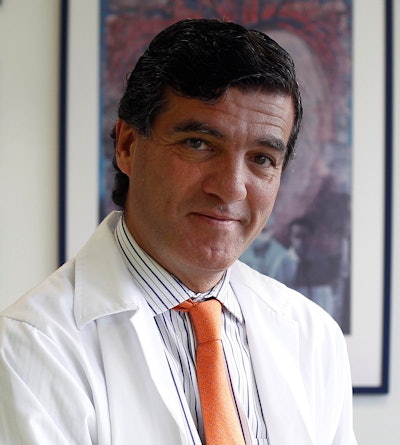
CT does have a crucial part to play in COVID-19 cases. That's the view of top cardiac imaging expert Dr. Stephan Achenbach, although he admits it only has a limited role and his department has so far only seen around 10 patients with the disease.
"We still have enough serologic test capacity, so we do not use CT for screening or primary diagnosis. We use CT, when necessary, for differential diagnoses/complications and to confirm pulmonary involvement to see if treatment decisions should be influenced in any way by the CT result," noted Achenbach, chair of the department of cardiology at Friedrich-Alexander-University Erlangen-Nürnberg in Germany.
 CT can help with treatment decisions for COVID-19 patients, notes Dr. Stephan Achenbach.
CT can help with treatment decisions for COVID-19 patients, notes Dr. Stephan Achenbach.Elderly patients with comorbidities have a higher death rate than younger patients, but there was no easy way to predict the clinical course of the disease, he added during the recent European Society of Cardiology (ESC) webinar titled "Clinical Presentation of Respiratory Failure in COVID-19 - FAQ."
In the same webinar, Dr. Pepe Zamorano explained that x-ray does not correlate well with the symptoms and status of a COVID-19 patient. Instead, oxygen saturation monitoring may provide the most accurate warning of patients at high risk of deterioration.
Zamorano, who is head of cardiology at Madrid's Hospital Ramón y Cajal, agreed that there seem to be no parameters that predict outcome reliably. He pointed out that patients whose x-rays seem to show an emergency situation may be relatively well; however, they could deteriorate rapidly and still need to be monitored closely, with particular attention paid to their oxygen saturation measurements.
In these patients, an immediate drop-off in oxygen saturation requires timely action -- namely, transfer of the patients to the intensive care unit.
"CT scans are better for diagnosis, but since there are hundreds of patients coming in every day, it is not really efficient to think in terms of CT scans for all," Zamorano said.
 X-ray has a limited role in patient monitoring, says Dr. Pepe Zamorano.
X-ray has a limited role in patient monitoring, says Dr. Pepe Zamorano.He noted that in his hospital, patients underwent x-ray scans at admission for the diagnosis of pneumonia, but they were monitored by oxygen saturation, which is faster and more efficient.
"Often you can see oxygen saturation of 95% but going down to 90% while the patient is simply moving to the bathroom," he said. "It is easy and fast to see that things are not going so well."
Most COVID-19 patients with respiratory failure can be stabilized in normal wards and then discharged, according to Zamorano. However, around 10% to 20% of patients will require ventilation, and this is a situation where thousands of patients will saturate intensive care unit capacity. Increased mortality in Italy and Spain over the past few days prior to the webinar was not due to the virus worsening but rather because the hospitals cannot intubate many patients, he continued.
All intensive care beds at the hospital in Madrid are now occupied by COVID-19 patients, and the hospital is considering dedicating the other 18 rooms to these cases as well.
Over the coming weeks, the ESC is planning another webinar more specifically covering the imaging of COVID-19 cases.
Meanwhile, the ESC announced on 30 March that it has canceled EuroHeartCare 2020, the annual scientific congress of the Association of Cardiovascular Nursing and Allied Professions (ACNAP), scheduled for 4-6 June in Seville, Spain.
"With severe measures being taken by hospitals to deal with the epidemic, a growing number of delegates have informed us that they are unable to travel. In addition, Spanish authorities have declared a lockdown to stop the spread of the infection," the organizers said in a statement.
The congress will take place next year in the same venue from 17 to 19 June.



















